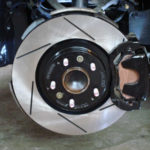Although the braking systems that Mercedes Benz install on their vehicles are usually reliable and powerful, issues can occur as the car gets older. Regular inspection and service can extend the longevity of any braking system, and when you notice problems arising, you should look to address them as soon as possible. And while complete brake failure isn’t frequent, a loss in braking power can be quite scary when driving and it may result in an accident. The most common reason for braking power loss is the wearing down of brake pads.

Once you notice they start wearing down, it’s essential to replace them with superior quality Mercedes Benz brake pads. But what are the characteristics of a quality Benz brake pad? Well, they should be durable, efficient, easy to install and long-lasting. But in order to determine these qualities, you need to consider a couple of factors first.
The Material Used to Make the Pads
Benz brake pads can be made from either organic, ceramic or semi-metallic materials. Semi-metallic brake pads offer great heat transfer and long-term durability. They’re the most common brake pads used today, and they’re usually made of steel wire or wool, copper or graphite and friction modifiers. These brakes can contain anywhere from 30-60% metal, and they’re noisier, wear the rotors down quicker and underperform at low temperatures. Organic brake pads are made using high-temperature resins, fibres and filler materials. When compared to semi-metallic brakes, organic brakes create less noise, are softer, but they create more dust and wear down faster. Lastly, ceramic brake pads contain a small amount of metal, and mostly ceramic fibres, nonferrous filler materials and bonding agents. They create less noise than semi-metallic brake pads, wear slower and create less dust. The only downside is that they’re more expensive.

Price and Fit
Obviously, the replacement brake pads should fit your Benz’ specific model, make and year for easy installation and optimal performance. Brake pads aren’t a one-size-fits-all type of part, which is why when ordering a replacement Benz brake pad, you need to make sure it’s the exact model replacement. And when it comes to price, you should know that brake pads, even those made of the same materials can come in a wide price range. You’ll oftentimes come across brake pads with comparable qualities where one is lower priced than the other. And although the price doesn’t always indicate quality, higher-priced pads usually seem to be more durable and have a longer lifespan.
How Long do Mercedes Benz Brake Pads Last?
The answer to this question depends on a few different factors, such as your driving habits, the type of brake pads, the environment, etc. In order to get the most out of your brake pads, you should frequently inspect them to ensure they’re in proper working conditions. Typically, a Benz brake pad will need to be replaced after about 80.000km. However, as aforementioned, that can vary based on a few different factors. If you want to check out the state of your brake pads, then you can do so in two ways.
One way is by using Vernier callipers. Although this check isn’t 100% accurate, it will still give you a good idea of the state of your pads. Vernier calipers are quite affordable and they can be used for a wide range of applications. All you have to do is stick the prong of the Vernier through your brake pad until you reach the disc, then push it inwards until the body of the Vernier touches the brake pad. Make sure it’s as straight as possible, and you should see a certain value on the display of the tool. The value displayed isn’t the most accurate, because you have to account for the brake pad backing plate that holds the brake, which is roughly 5 millimetres, so you should deduct that number from the value on the display.

Another way is to measure the width of the disc by using a straw and a marker. It’s a similar method to using Vernier’s, but it’s less accurate. All you have to do is slide the straw through the pad and mark the straw. Once you’ve marked it, cut the excess part and measure what’s left. Again, you’ll need to deduct 5 millimetres and that will get you results that are somewhat accurate.
When Should You Replace the Brake Pads?
You want to have at least 4mm before changing your pads. Brand new ones will usually come with 11 mm. Another way to spot that your pads aren’t in proper working condition anymore is the presence of rust. Further, you may hear squeaky sounds coming from the wheels when you brake, which is also a sure sign of wear. Lastly, if your steering wheel and entire car shake every time you stop, then that can also mean the brake pads are warped.


